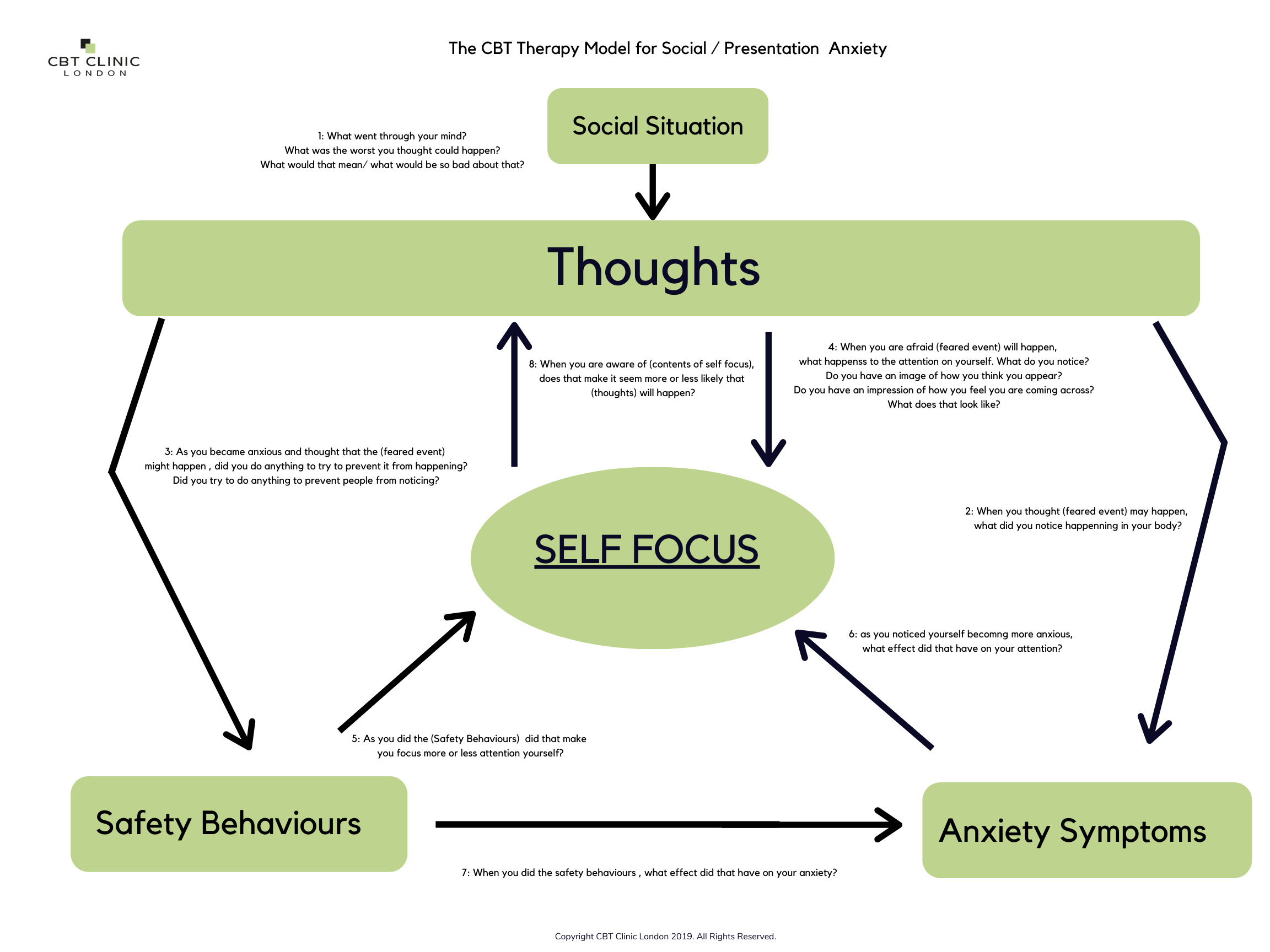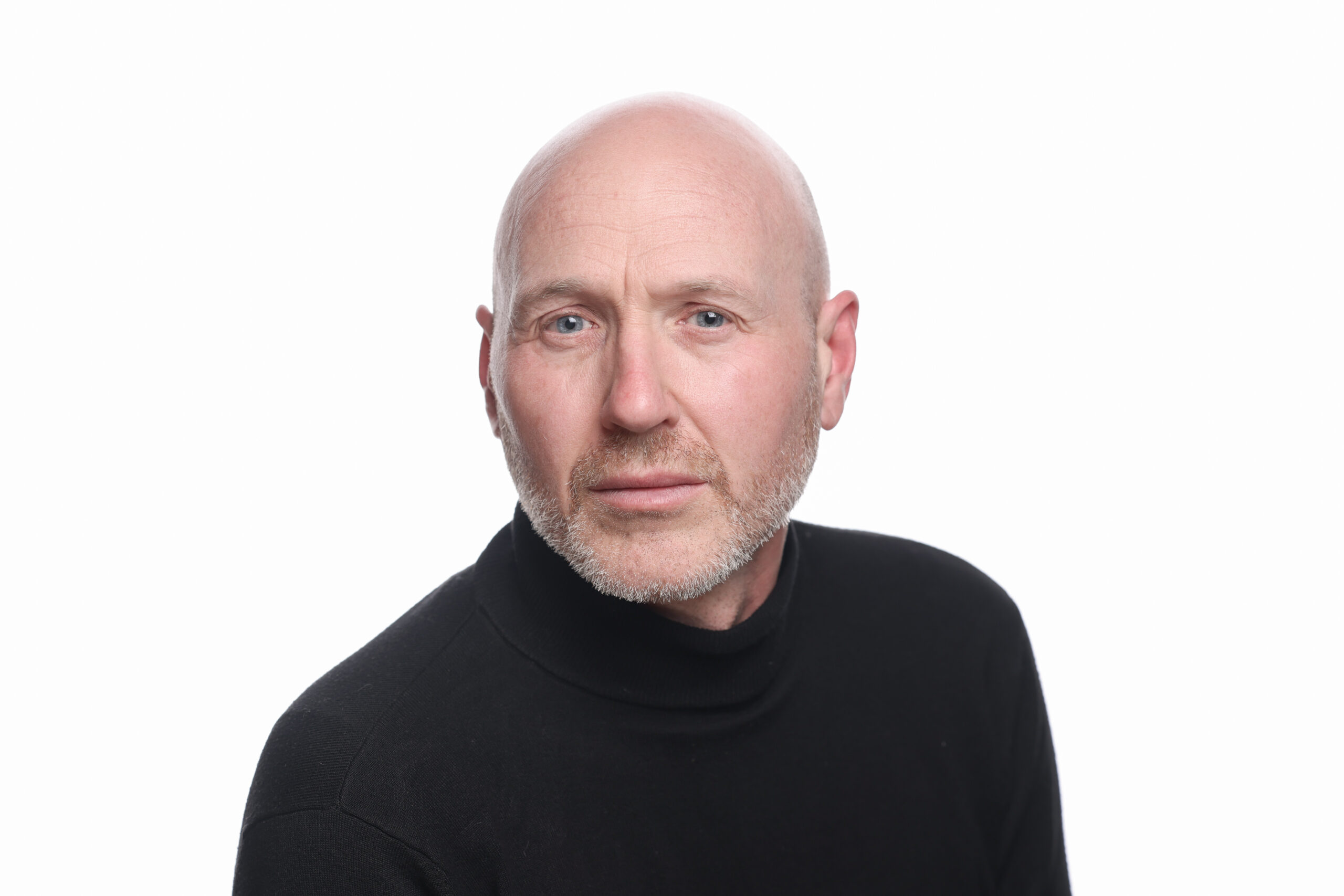CBT Therapy : Social Anxiety
Effective Treatment : Social Anxiety
Social Anxiety (SA)
A person with social anxiety has significant anxiety and discomfort about being embarrassed, humiliated, rejected or looked down on in social interactions. People with this disorder will try to avoid the situation or endure it with great anxiety. Common examples are extreme fear of public speaking, meeting new people or eating/drinking in public. The fear or anxiety causes problems with daily functioning and socialising.
Social anxiety disorder (previously known as ‘social phobia’) is one of the most common of the anxiety disorders. Estimates of lifetime prevalence vary but according to a US study, 12% of adults in the US will have social anxiety disorder at some point in their lives, compared with estimates of around 6% for generalised anxiety disorder (GAD), 5% for panic disorder, 7% for post-traumatic stress disorder (PTSD) and 2% for obsessive–compulsive disorder. There is a significant degree of comorbidity between social anxiety disorder and other mental health problems, most notably depression (19%), substance-use disorder (17%), GAD (5%), panic disorder (6%), and PTSD (3%).
Social anxiety disorder is persistent fear of or anxiety about one or more social or performance situations that is out of proportion to the actual threat posed by the situation. Typical situations that might be anxiety-provoking include meeting people, including strangers, talking in meetings or in groups, starting conversations, talking to authority figures, working, eating or drinking while being observed, going to school, going shopping, being seen in public, using public toilets and public performances such as public speaking. Although worries about some of these situations are common in the general population, people with social anxiety disorder worry excessively about them at the time and before and afterwards. They fear that they will do or say something that they think will be humiliating or embarrassing (such as blushing, sweating, appearing boring or stupid, shaking, appearing incompetent, looking anxious). Social anxiety disorder can have a great impact on a person’s functioning, disrupting normal life, interfering with social relationships and quality of life and impairing performance at work or school. People with the disorder may misuse alcohol or drugs to try to reduce their anxiety (and alleviate depression).
Children may show their anxiety in different ways from adults: as well as shrinking from interactions, they may be more likely to cry, freeze or have tantrums. They may also be less likely to acknowledge that their fears are irrational when they are away from a social situation. Particular situations that can cause difficulty for socially anxious children and young people include participating in classroom activities, asking for help in class, joining activities with peers (such as attending parties or clubs), and being involved in school performances.
Social anxiety disorder has an early median age of onset (13 years) and is one of the most persistent anxiety disorders. Despite the extent of distress and impairment, only about half of those with the disorder ever seek treatment, and those who do generally only seek treatment after 15–20 years of symptoms. A significant number of people who develop social anxiety disorder in adolescence may recover before reaching adulthood. However, if the disorder has persisted into adulthood, the chance of recovery in the absence of treatment is modest when compared with many other common mental health problems.
Source: NICE Guidelines 2023
Patient Quote
“I was always avoiding giving presentations at work and it started to affect my promotion prospects. The CBT Therapy helped me to manage my anxiety and significantly reduce my fear of looking stupid or blushing. ”
Marco. Consultant
Symptoms of social anxiety
Social anxiety is more than shyness. It’s a fear that does not go away and affects everyday activities, self confidence, relationships and work or school life.
Many people occasionally worry about social situations, but someone with social anxiety feels overly worried before, during and after them.
You may have social anxiety if you:
- worry about everyday activities, such as meeting strangers, starting conversations, speaking on the phone, working or shopping
- avoid or worry a lot about social activities, such as group conversations, eating with company and parties
- always worry about doing something you think is embarrassing, such as blushing, sweating or appearing incompetent
- find it difficult to do things when others are watching – you may feel like you’re being watched and judged all the time
- fear being criticised, avoid eye contact or have low self-esteem
- often have symptoms like feeling sick, sweating, trembling or a pounding heartbeat (palpitations)
- have panic attacks, where you have an overwhelming sense of fear and anxiety, usually only for a few minutes
Many people with social anxiety also have other mental health issues, such as depression, generalised anxiety disorder or panic disorder.
Source: NHS Website
We really don’t know. It seems to affect people who:
- have particularly high standards for their behaviour in public;
- who have stammered as a child.
Some experts think that it might be due to people getting stuck at the normal stage of shyness that all children go through between the ages of three and seven.
What keeps it going?
Thoughts: Certain thoughts tend to kick in when you enter a social situation and will make you anxious. These include:
- rules for yourself – “I always have to look clever and in control”
- beliefs about yourself – “I’m boring”
- predictions about the future – “If someone gets to know me, they will see how inadequate I am.”
They make you think about – and criticise – your behaviour from moment to moment. Such thoughts are so automatic that they feel true to you – although there is often no evidence for them at all. They can make you imagine that you appear to other people in a certain – usually rather unattractive way. Ths is almost certainly very different from the way that people actually do see you.
Safety behaviours
These are things that you do to make yourself feel more in control in a social situation. They include:
- drinking alcohol
- avoiding eye contact
- avoiding social situations
- holding onto objects tightly
- not saying anything personal about yourself
- asking too many questions of the other person.
The problem with doing this is that it doesn’t allow you to experience the fact that dreadful things don’t happen if you stop trying to control your behaviour so much.
Anticipation and post-mortems
Thinking over and over about a social situation, before or after, tends to make you focus on past ‘failures’. It strengthens your habit of over-scrutinising your behaviour and criticising yourself.
Source: Royal College Psychiatry
Psychological treatments for Social Anxiety:
Initial treatment options for adults with social anxiety disorder
Offer adults with social anxiety disorder individual cognitive behavioural therapy (CBT Therapy) that has been specifically developed to treat social anxiety disorder (based on the Clark and Wells model or the Heimberg model.
Delivering psychological interventions for adults
Individual CBT Therapy (the Clark and Wells model) for social anxiety disorder should consist of up to 14 sessions of CBT Therapy in 90 minutes’ duration over approximately 4 months and include the following:
- education about social anxiety
- experiential exercises to demonstrate the adverse effects of self-focused attention and safety-seeking behaviours
- video feedback to correct distorted negative self-imagery
- systematic training in externally focused attention
- within-session behavioural experiments to test negative beliefs with linked homework assignments
- discrimination training or rescripting to deal with problematic memories of social trauma
- examination and modification of core beliefs
- modification of problematic pre- and post-event processing
- relapse prevention.
Individual CBT Therapy (the Heimberg model) for social anxiety disorder should consist of 15 sessions of CBT Therapy 60 minutes’ duration, and 1 session of 90 minutes for exposure, over approximately 4 months, and include the following:
- education about social anxiety
- cognitive restructuring
- graduated exposure to feared social situations, both within treatment sessions and as homework
- examination and modification of core beliefs
- relapse prevention.
Source: NICE 2023
Attention Training
Past Experience Processing
Targeting Safety Beahviours
Clark and Wells Model for Social Anxiety (CBT Therapy)

Heimberg Model for Social Anxiety (CBT Therapy)

- Fear of scrutiny by other people leading to avoidance of social situations. More pervasive social phobias are usually associated with low self-esteem and fear of criticism. They may present as a complaint of blushing, hand tremor, nausea, or urgency of micturition, the patient sometimes being convinced that one of these secondary manifestations of their anxiety is the primary problem. Symptoms may progress to panic attacks.
- Anthropophobia
- Social neurosis
Book a Free Consultation with a CBT Therapist in London:
We have facilitated the successful recovery of many people who suffer from Social Anxiety.
If you would like help with Social Anxiety then get in touch with us using the form below.
CBT Therapist London
This article was curated by Alistair Bond – Senior CBT Therapist in London. He is the Clinical Director of the CBT Clinic London and he specialises in treating Social Anxiety with CBT Therapy.
If you or a loved one are struggling with Social Anxiety, please get in touch with us. You can call our friendly reception team on 0207 157 9924, email info@cbtcliniclondon.com or simply fill out our new patient registration form and we’ll get back to you.


